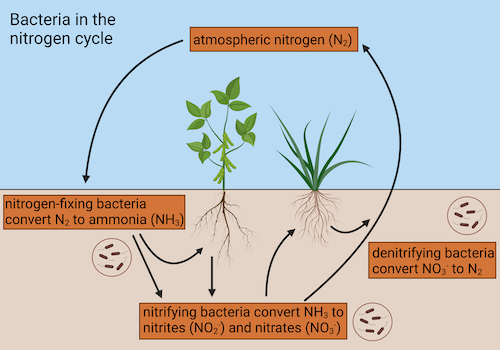Nitrogen cycle
The element nitrogen is essential for life. DNA, RNA, and protein molecules all contain nitrogen atoms.
The largest reservoir of nitrogen on Earth is the atmosphere, with nitrogen gas (\[\ce{N2}\]) making up about 78% of air. However, plants and animals cannot directly use this nitrogen gas. To get the forms of nitrogen they need, these organisms rely on the nitrogen cycle.
The nitrogen cycle is the cyclic movement of nitrogen in different chemical forms between living organisms and the environment. The steps of the nitrogen cycle are described below.
Nitrogen fixation: During this step, atmospheric nitrogen gas is fixed, or converted into a form that can be used by plants and animals. Two natural processes are responsible for most nitrogen fixation.
In the atmosphere, energy from lightning helps recombine the atoms in nitrogen gas and oxygen gas (\[\ce{O2}\]), forming nitrate (\[\ce{NO3-}\]). This nitrate falls to Earth's surface in precipitation.
In the soil, nitrogen-fixing bacteria use enzymes to combine nitrogen gas with hydrogen gas (\[\ce{H2}\]) to produce ammonia (\[\ce{NH3}\]). The bacteria can use this ammonia as a nutrient, or convert it into ammonium ions (\[\ce{NH4+}\]).
Fixed nitrogen can be taken up by plants and incorporated into biological molecules in the plants’ tissues. This allows nitrogen to move up the food chain as plants are eaten by animals, who are themselves eaten.
Ammonification: Nitrogen-containing biological molecules may stay in organisms’ tissues, or be broken down and released as waste. As dead organisms and waste decompose, ammonia and ammonium ions are returned to the environment through ammonification. This process is carried out by certain bacteria and fungi.
Nitrification: During nitrification, groups of nitrifying bacteria convert the products of ammonification into nitrites (\[\ce{NO2-}\]), and then nitrates.
Denitrification: During denitrification, denitrifying bacteria convert nitrites and nitrates back into nitrogen gas, returning nitrogen to the atmosphere.
The nitrogen cycle tends to occur faster than other major nutrient cycles because living, active bacteria control many of the chemical transformations of nitrogen.
